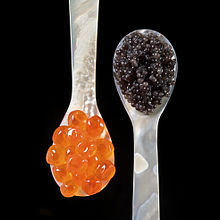Caviar spoon: Difference between revisions
ClueBot NG (talk | contribs) m Reverting possible vandalism by 66.108.74.208 to version by Richjordana. False positive? Report it. Thanks, ClueBot NG. (987521) (Bot) |
Undid revision 484864497 by ClueBot NG (talk) Tag: reverting anti-vandal bot |
||
| Line 3: | Line 3: | ||
[[File:Caviar spoons.jpg|thumb|caviar spoons]] |
[[File:Caviar spoons.jpg|thumb|caviar spoons]] |
||
'''Caviar spoons''' are typically made of Mother of Pearl [[Nacre]], bone or horn. [[Mother of pearl]] is ideal for serving caviar because, unlike sterling or stainless, it does not affect the caviar's fragile flavor. Mother of pearl is chemically inert, which means it cannot transfer any unpleasant flavors to the caviar. [[ |
'''Caviar spoons''' are typically made of Mother of Pearl [[Nacre]], bone or horn. [[Mother of pearl]] is ideal for serving caviar because, unlike sterling or stainless, it does not affect the caviar's fragile flavor. Mother of pearl is chemically inert, which means it cannot transfer any unpleasant flavors to the caviar. The reason for using mother of pearl, bone, or horn is the popular conception that [[caviar]] should always be served from a non-metal spoon, because metal will impart a metallic flavor to the granules. {{Citation needed}} Some food experts, state, however, state that the idea that metal spoons should be avoided is a popular misconception; they pointing out that fine caviar is typically stored and transported in metal tins. <ref>{{cite web|last=About.com|title=Gourmet Food - Storing and Serving Caviar|url=http://gourmetfood.about.com/od/caviar/a/servcaviar.htm|accessdate=4/1/2012}}</ref> <ref>{{cite web|last=Gatewat Gourmet|title=All About Caviar|url=http://www.wisegeek.com/what-is-a-caviar-spoon.htm|accessdate=4/1/12}}</ref> |
||
a metallic flavor to the granules. |
|||
Caviar spoons range in size from 3-5 inches and have a small shallow bowl. The head of the spoon is either oval or paddle shaped. |
Caviar spoons range in size from 3-5 inches and have a small shallow bowl. The head of the spoon is either oval or paddle shaped. |
||
| Line 18: | Line 17: | ||
A large, flame-point grindstone can be used on the outside surface. The surface is removed until it has an even, white texture. Fine sandpaper is used to smooth the surfaces. Emery paper, which has a very fine grit, can be used for the fine polishing in the last steps of sanding. |
A large, flame-point grindstone can be used on the outside surface. The surface is removed until it has an even, white texture. Fine sandpaper is used to smooth the surfaces. Emery paper, which has a very fine grit, can be used for the fine polishing in the last steps of sanding. |
||
The final product is finished with felt buffing bits to impart a high-gloss sheen on the surfaces of the shell. |
The final product is finished with felt buffing bits to impart a high-gloss sheen on the surfaces of the shell. |
||
==References== |
|||
{{reflist}} |
|||
[[Category:Spoons]] |
[[Category:Spoons]] |
||
Revision as of 16:33, 31 March 2012



Caviar spoons are typically made of Mother of Pearl Nacre, bone or horn. Mother of pearl is ideal for serving caviar because, unlike sterling or stainless, it does not affect the caviar's fragile flavor. Mother of pearl is chemically inert, which means it cannot transfer any unpleasant flavors to the caviar. The reason for using mother of pearl, bone, or horn is the popular conception that caviar should always be served from a non-metal spoon, because metal will impart a metallic flavor to the granules. [citation needed] Some food experts, state, however, state that the idea that metal spoons should be avoided is a popular misconception; they pointing out that fine caviar is typically stored and transported in metal tins. [1] [2]
Caviar spoons range in size from 3-5 inches and have a small shallow bowl. The head of the spoon is either oval or paddle shaped.
Manufacturing
Caviar spoons are carved from bone, horn or the inner layer of oyster shells using a fretsaw. Once the spoon is shaped, a grinder is used to smooth and buff the sharp edges.
The first step in the manufacturing process is to trace the shape of the design on the shell. The shape is then rough-cut using a fretsaw or a narrow cutting disc at medium speed.
The spoon pattern is then refined using larger and coarser grindstone bits. Refinements such as beveling the edges are accomplished by using successively finer grades of grindstones. The grindstones are then used to remove the surface of the outside back of the shell.
A large, flame-point grindstone can be used on the outside surface. The surface is removed until it has an even, white texture. Fine sandpaper is used to smooth the surfaces. Emery paper, which has a very fine grit, can be used for the fine polishing in the last steps of sanding. The final product is finished with felt buffing bits to impart a high-gloss sheen on the surfaces of the shell.
References
- ^ About.com. "Gourmet Food - Storing and Serving Caviar". Retrieved 4/1/2012.
{{cite web}}: Check date values in:|accessdate=(help) - ^ Gatewat Gourmet. "All About Caviar". Retrieved 4/1/12.
{{cite web}}: Check date values in:|accessdate=(help)
